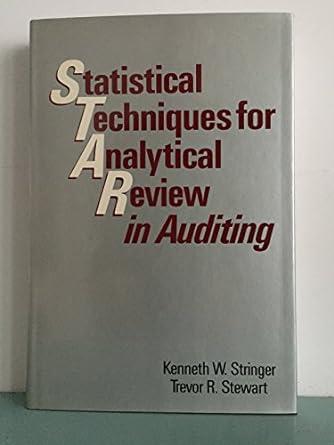Answered step by step
Verified Expert Solution
Question
1 Approved Answer
CBI's controller believes that the company's traditional costing system may be providing misleading cost information. To determine whether or not this is correct, the controller
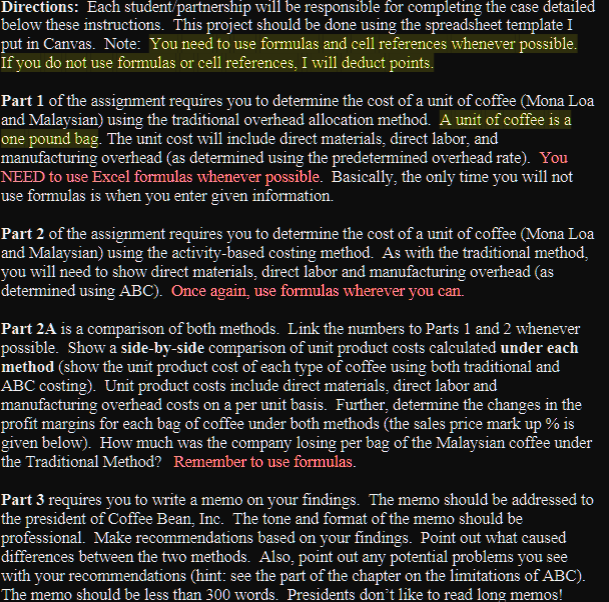
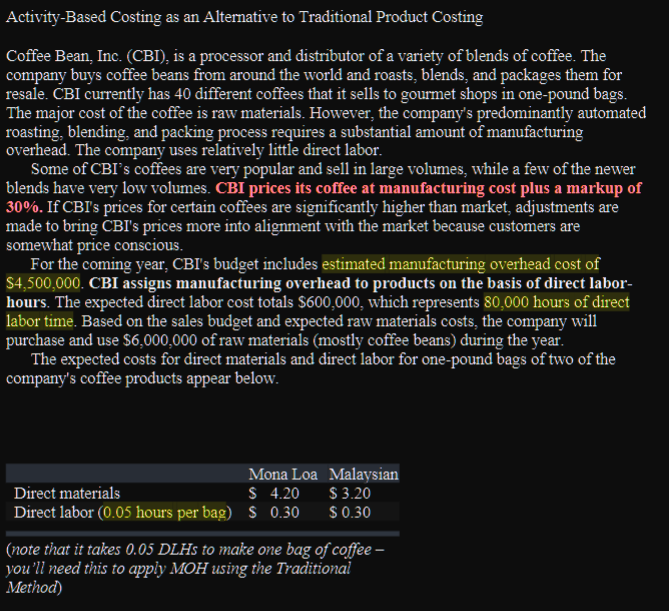
CBI's controller believes that the company's traditional costing system may be providing misleading cost information. To determine whether or not this is correct, the controller has prepared an analysis of the years expected manufacturing overhead costs, as shown in the
following table:
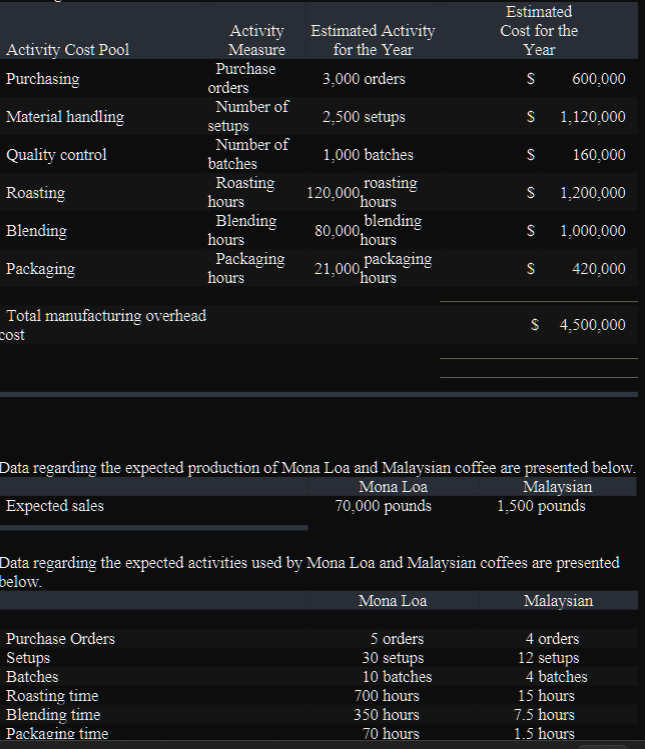
Could you Answer it here:
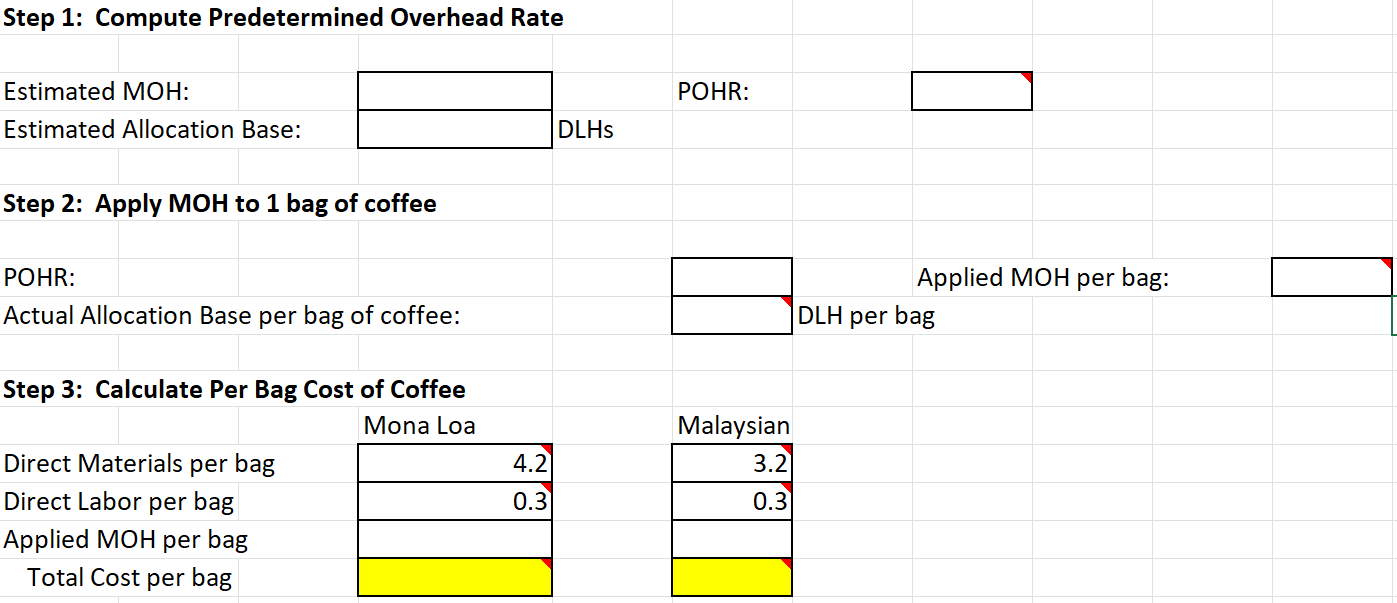

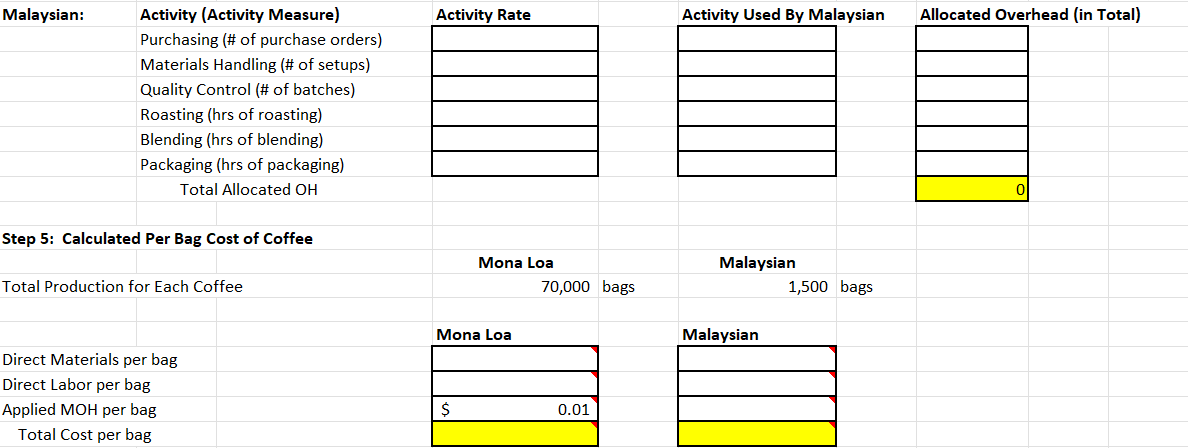

Could you answer the stuff on excel I put down.
\begin{tabular}{|c|c|c|c|c|} \hline Activity Cost Pool & \begin{tabular}{l} Activity \\ Measure \end{tabular} & \begin{tabular}{l} Estimated Activity \\ for the Year \end{tabular} & \begin{tabular}{l} Estima \\ Cost fo \\ Yea \end{tabular} & \begin{tabular}{l} Ited \\ r the \\ I \end{tabular} \\ \hline Purchasing & \begin{tabular}{l} Purchase \\ orders \end{tabular} & 3,000 orders & s & 600,000 \\ \hline Material handling & \begin{tabular}{l} Number of \\ setups \end{tabular} & 2,500 setups & s & 1,120,000 \\ \hline Quality control & \begin{tabular}{l} Number of \\ batches \end{tabular} & 1,000 batches & s & 160,000 \\ \hline Roasting & \begin{tabular}{l} Roasting \\ hours \end{tabular} & 120,000hoursroasting & s & 1,200,000 \\ \hline Blending & \begin{tabular}{l} Blending \\ hours \end{tabular} & 80,000hoursblending & s & 1,000,000 \\ \hline Packaging & \begin{tabular}{l} Packaging \\ hours \end{tabular} & 21,000 packaging & s & 420,000 \\ \hline \begin{tabular}{l} Total manufacturing overhead \\ cost \end{tabular} & & & s & 4,500,000 \\ \hline \end{tabular} Data regarding the expected production of Mona Loa and Malaysian coffee are presented below. \begin{tabular}{lcc} Expected sales & Mona Loa & Malaysian \\ & & \\ Data regarding the expected activities used by Mona Loa and Malaysian coffees are presented \\ below. \\ & & \\ & Mona Loa & Malaysian \\ Purchase Orders & & \\ Setups & 5 orders & 4 orders \\ Batches & 30 setups & 12 setups \\ Roasting time & 10 batches & 4 batches \\ Blending time & 700 hours & 15 hours \\ Packaging time & 350 hours & 7.5 hours \\ \end{tabular} Activity-Based Costing as an Alternative to Traditional Product Costing Coffee Bean, Inc. (CBI), is a processor and distributor of a variety of blends of coffee. The company buys coffee beans from around the world and roasts, blends, and packages them for resale. CBI currently has 40 different coffees that it sells to gourmet shops in one-pound bags. The major cost of the coffee is raw materials. However, the company's predominantly automated roasting, blending, and packing process requires a substantial amount of manufacturing overhead. The company uses relatively little direct labor. Some of CBI's coffees are very popular and sell in large volumes, while a few of the newer blends have very low volumes. CBI prices its coffee at manufacturing cost plus a markup of 30%. If CBI's prices for certain coffees are significantly higher than market, adjustments are made to bring CBI's prices more into alignment with the market because customers are somewhat price conscious. For the coming year, CBI's budget includes estimated manufacturing overhead cost of $4,500,000. CBI assigns manufacturing overhead to products on the basis of direct laborhours. The expected direct labor cost totals $600,000, which represents 80,000 hours of direct labor time. Based on the sales budget and expected raw materials costs, the company will purchase and use $6,000,000 of raw materials (mostly coffee beans) during the year. The expected costs for direct materials and direct labor for one-pound bags of two of the company's coffee products appear below. Directions: Each student partnership will be responsible for completing the case detailed below these instructions. This project should be done using the spreadsheet template I put in Canvas. Note: You need to use formulas and cell references whenever possible. If you do not use formulas or cell references, I will deduct points. Part 1 of the assignment requires you to determine the cost of a unit of coffee (Mona Loa and Malaysian) using the traditional overhead allocation method. A unit of coffee is a one pound bag. The unit cost will include direct materials, direct labor, and manufacturing overhead (as determined using the predetermined overhead rate). You NEED to use Excel formulas whenever possible. Basically, the only time you will not use formulas is when you enter given information. Part 2 of the assignment requires you to determine the cost of a unit of coffee (Mona Loa and Malaysian) using the activity-based costing method. As with the traditional method, you will need to show direct materials, direct labor and manufacturing overhead (as determined using ABC ). Once again, use formulas wherever you can. Part 2A is a comparison of both methods. Link the numbers to Parts 1 and 2 whenever possible. Show a side-by-side comparison of unit product costs calculated under each method (show the unit product cost of each type of coffee using both traditional and ABC costing). Unit product costs include direct materials, direct labor and manufacturing overhead costs on a per unit basis. Further, determine the changes in the profit margins for each bag of coffee under both methods (the sales price mark up % is given below). How much was the company losing per bag of the Malaysian coffee under the Traditional Method? Remember to use formulas. Part 3 requires you to write a memo on your findings. The memo should be addressed to the president of Coffee Bean, Inc. The tone and format of the memo should be professional. Make recommendations based on your findings. Point out what caused differences between the two methods. Also, point out any potential problems you see with your recommendations (hint: see the part of the chapter on the limitations of ABC ). The memo should be less than 300 words. Presidents don't like to read long memos! Activity-Based Costing Step 1: Determine Overhead Driving Activities. This is given in the instructions. Step 2: Allocate Overhead Costs Between Activities Identified in Step 1 (First Stage of Allocation). This is given in the instructions. Step 3: Calculate Activity Rates. Activity (Activity Measure) Purchasing (\# of purchase orders) Materials Handling (\# of setups) Quality Control (\# of batches) Roasting (hrs of roasting) Blending (hrs of blending) Packaging (hrs of packaging) Step 4: Allocate Overhead. Mona Loa: Activity (Activity Measure) Purchasing (\# of purchase orders) Materials Handling (\# of setups) Quality Control (\# of batches) Roasting (hrs of roasting) Blending (hrs of blending) Packaging (hrs of packaging) Total Allocated OH \begin{tabular}{l} Estimated Overhead \\ \hline$600,000 \\ \hline \\ \hline \\ \hline \\ \hline \\ \hline \end{tabular} Activity Rate \begin{tabular}{|l|} \hline$200.00 \\ \hline \\ \hline \\ \hline \\ \hline \\ \hline \end{tabular} Estimated Activity \begin{tabular}{|r|} \hline 3,000 \\ \hline \\ \hline \\ \hline \\ \hline \\ \hline \\ \hline \end{tabular} Activity Used By Mona Loa \begin{tabular}{|l|} \hline \\ \hline \\ \hline \\ \hline \\ \hline \\ \hline \\ \hline \end{tabular} Activity Rate $200.00 per order per setup per batch per hr of roasting per hr of blending per hr of packaging Allocated Overhead (in Total) \begin{tabular}{|ll|} \hline$ & 1,000 \\ \hline & \\ \hline & \\ \hline & \\ \hline & \\ \hline & \\ \hline$ & 1,000 \\ \hline \end{tabular} Step 1: Compute Predetermined Overhead Rate Estimated MOH: Estimated Allocation Base: Step 2: Apply MOH to 1 bag of coffee POHR: Actual Allocation Base per bag of coffee: Step 3: Calculate Per Bag Cost of Coffee Direct Materials per bag Direct Labor per bag Applied MOH per bag Total Cost per bag \begin{tabular}{|c|c|c|c|c|c|} \hline \multicolumn{2}{|c|}{ Traditional Costing Per Unit Cost } & & \multicolumn{2}{|c|}{ Activity-Based Costing Per Unit Cost } & \\ \hline & Mona Loa & Malaysian & & Mona Loa & Malaysian \\ \hline Direct Materials per bag & 4.2 & & Direct Materials per bag & & \\ \hline Direct Labor per bag & 0.3 & & Direct Labor per bag & & \\ \hline Applied MOH per bag & 0 & & Applied MOH per bag & & \\ \hline Total Cost per bag & & & Total Cost per bag & & \\ \hline \multirow[b]{2}{*}{ Sales Price Per Bag } & & & & & \\ \hline & 0 & & & & \\ \hline & & & & \\ \hline & & & & & \\ \hline & & & & & \\ \hline \end{tabular}Step by Step Solution
There are 3 Steps involved in it
Step: 1

Get Instant Access to Expert-Tailored Solutions
See step-by-step solutions with expert insights and AI powered tools for academic success
Step: 2

Step: 3

Ace Your Homework with AI
Get the answers you need in no time with our AI-driven, step-by-step assistance
Get Started


